
Pilgrims Rest
 Pilgrims Rest, a little town or more a village in the east, north of Nelspruit. Geo-position: 24.9089°S, 30.75737°E and 1293m amsl, that is the position of the Royal Hotel. The village stretches mostly along the road over a distance of about 1.6km.
Pilgrims Rest, a little town or more a village in the east, north of Nelspruit. Geo-position: 24.9089°S, 30.75737°E and 1293m amsl, that is the position of the Royal Hotel. The village stretches mostly along the road over a distance of about 1.6km.
It originated as a camp at the diggings, that was for gold, during the 1870th. All its history, with short interruptions, until today centred around gold. The whole town is now a museum, run by the province, Mpumalanga.
History
Karl Mauch can be considered to be the father of gold discoveries in the area. A German explorer, he toured up and down the northern territories, collecting rocks and panning for gold. He didn't find very much but enough of the stuff to predict that there is payable Gold in those hills.
It wetted the appetite for prospectors to get into the area, the first strike was at Mac Mac, south from the present Graskop. Discovering the major gold field at Pilgrims Rest was only a question of time. Space doesn't allow me to write the full story on how it came about, it can be found in ref 2. It was in September 1873 that Wheelbarrow Alec set himself up, in secret, to wash alluvial gold from the stream flowing through the later Pilgrims Rest. A major gold rush followed when he was 'discovered' and othe diggers came into the valley. At this point Alec picked up his wheelbarrow and left, never be seen again.
Up to 1500 diggers were working the field along the valley, at that time all alluvial gold. By 1876 many of the claims had been worked out. Prospectors had been moving out into the hills where they found gold in reefs embedded between rock layers. To get to that gold required different machinery and thus more capital. In 1881 David Benjamin, a London financier, formed the Transvaal Gold Exploration Company to extract the gold from the reefs. And 1895 this company amalgamated with a number of other small companies to form the Transvaal Gold Mining Estate (TGME).
The character of buildings in the town slowly changed from the initial shelters to houses mostly clad in corrugated iron. This trend was accelerated when mining moved into the hills and when TGME became the only mining company of the area. This company provided all the houses to be rented out to the mine employees. Thus the houses never changed and remained as built during the end of the 19th and beginning of the 20th century.
Mining stopped in 1972, but in 1990 TGME started again to rework the old mine dumps. That came to an end in 2015, but not prospecting, that is still going on, even today.
Gold Coins
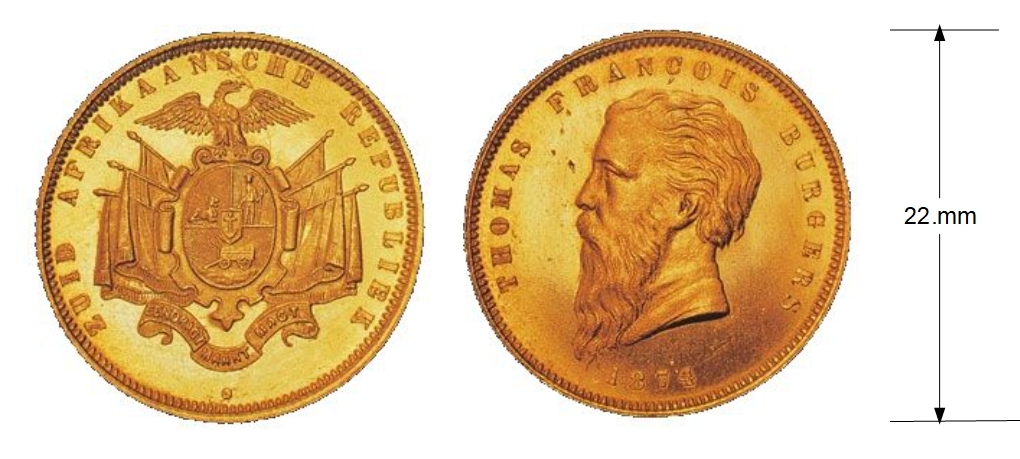 Worth mentioning here are the gold coins minted from Pilgrims Rest gold. The first one was a coin initiated by President Burger in 1874. The financial situation of the republic was in a precarious position, minting a gold coin was Burgers attempt to get the finances into a better position. This was going to be just the beginning of a coinage to be established. He had some of the gold sent to London and 837 coins were struck, each containing 4.6 gram of gold. Thus a fairly small coin. Showing the coat-of-arms on the one side and Burger's profile on the other. And it was this profile that caused considerable problems with some of the very conservative burgers. But they couldn't change it. The coin hardly went into circulation, most landed with horders and collectors. Nowadays, if you can get hold of such a coin, you would have to pay up to $72000. That was the price paid at an auction early 2025.
Worth mentioning here are the gold coins minted from Pilgrims Rest gold. The first one was a coin initiated by President Burger in 1874. The financial situation of the republic was in a precarious position, minting a gold coin was Burgers attempt to get the finances into a better position. This was going to be just the beginning of a coinage to be established. He had some of the gold sent to London and 837 coins were struck, each containing 4.6 gram of gold. Thus a fairly small coin. Showing the coat-of-arms on the one side and Burger's profile on the other. And it was this profile that caused considerable problems with some of the very conservative burgers. But they couldn't change it. The coin hardly went into circulation, most landed with horders and collectors. Nowadays, if you can get hold of such a coin, you would have to pay up to $72000. That was the price paid at an auction early 2025.
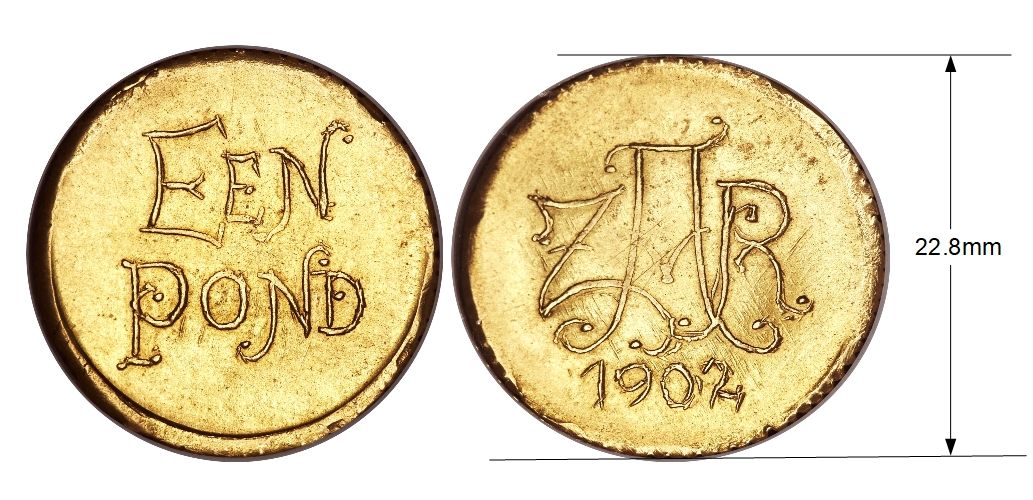 The other coin is the veldpond. During the Anglo Boer war the British never occupied the town, it had no strategic importance to them. Thus it was used by the comandoes to have a rest between engagements. The relationship with the town's people was quiete amenable. There were even tennis matches played and in December 1901 there was even a sportsday.
The other coin is the veldpond. During the Anglo Boer war the British never occupied the town, it had no strategic importance to them. Thus it was used by the comandoes to have a rest between engagements. The relationship with the town's people was quiete amenable. There were even tennis matches played and in December 1901 there was even a sportsday.
The republik was desperately short of coinage to pay for supplies. Thus a mint was set up in Pilgrims Rest to strike some coins from the gold brought up from Pretoria and from the TGME mines in the area. Mr P.J.Kloppers, a schoolmaster from Barberton was apointed to be head of the mint. The official title was 'Staatsmunt te Velde', tarnslated State Mint in the Field. Mr Kloppers went to work to see what can be done, it was a difficult task, but at the end he and his team struck 986 veldponde. They would look rather crude, but given the circumstatnces it was a master piece.
Of couse, these veldponde became a well sought after collectors items. One has to pay a small fortune to aquire one of these. Two pieces came onto an auction on 13-January-2025 and fetched $15600 and $33600.
Royal Hotel
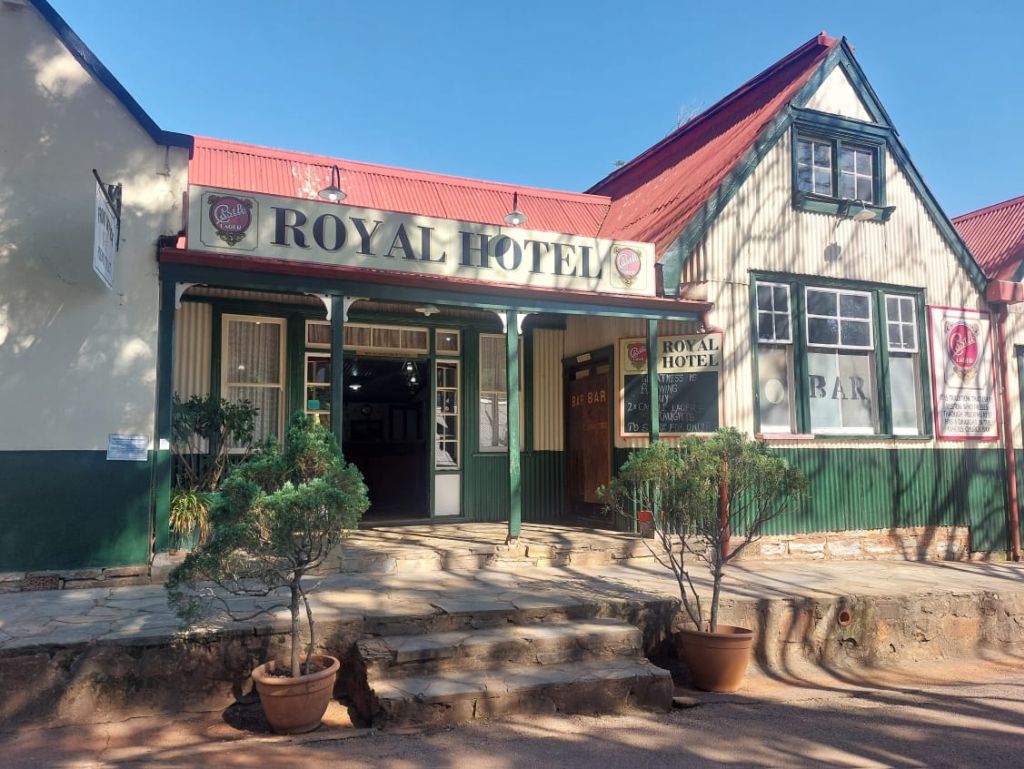 The Royal Hotel, one of the historical attractions of the town, was built by George Edward Roy in 1894. He came to the diggings in 1877 and made some money so that he could build this hotel. His wife was a daughter of Tom McLachlan, one of the pioneers of the digging at Kaapsehoop.
The Royal Hotel, one of the historical attractions of the town, was built by George Edward Roy in 1894. He came to the diggings in 1877 and made some money so that he could build this hotel. His wife was a daughter of Tom McLachlan, one of the pioneers of the digging at Kaapsehoop.
Something interesting was the origin of the bar. Before it came to Pilgrims Rest it was the Catholic chapel of the St.Cyprian's School in Cape Town. It was dismantled there and the pieces shipped off to Delgoa Bay, nowadays Maputo. From there taken by ox-wagon up to Pilgrims Rest. I have no information when that was.
In 1913 he sold it on to John McIntyre, who extended the building. And from there it had a number of owners until it finally went to the Transvaal Provincial Administration after 1972. The whole town was then declared a National Monument.
Cemetery
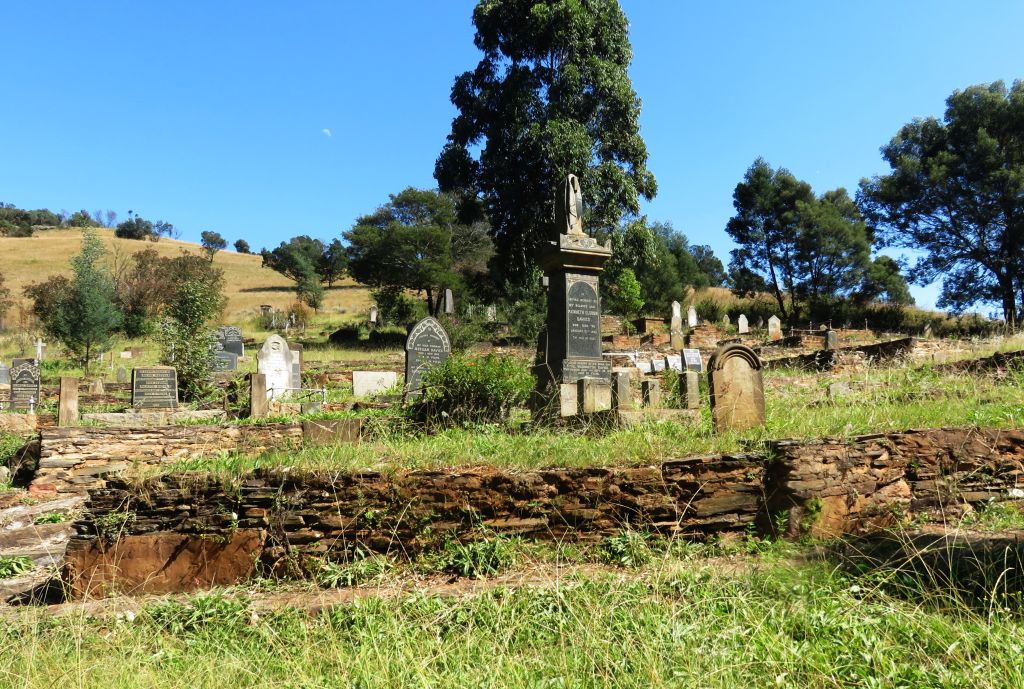
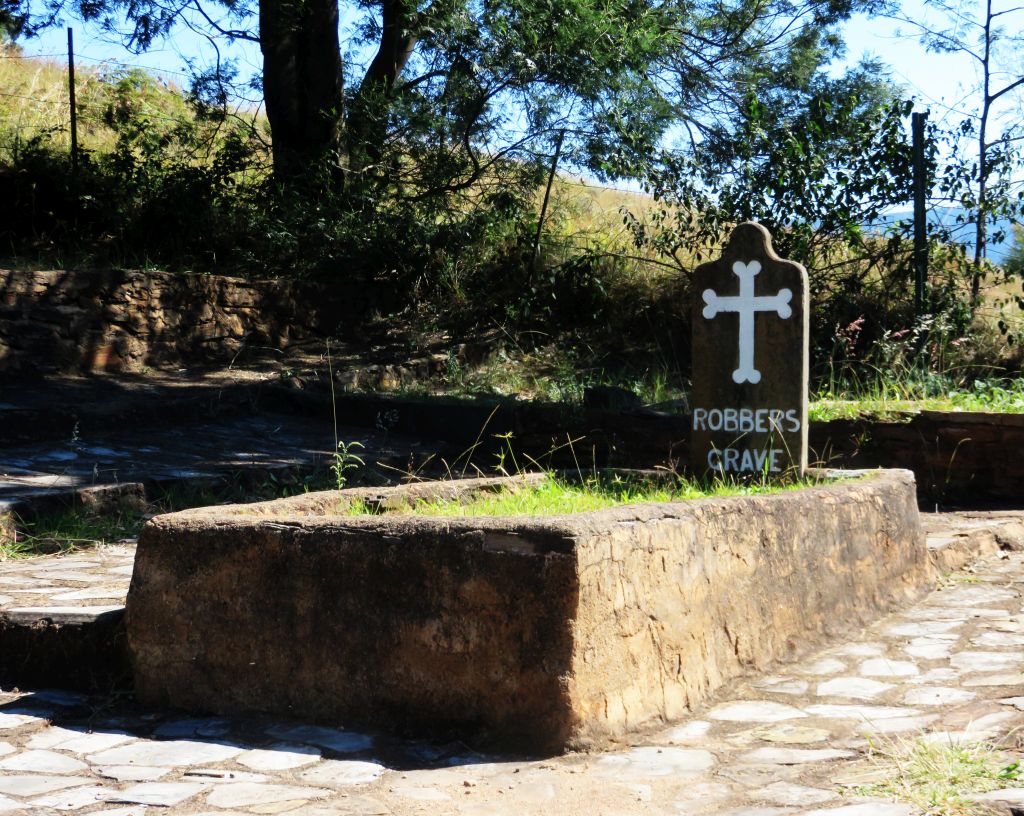 The most prominent grave, and the grave that got the the grave yard started, is that of the robber. There is no name , its just says 'robbers grave'. To explain further I just copy from the brochure I got at the museum.
The most prominent grave, and the grave that got the the grave yard started, is that of the robber. There is no name , its just says 'robbers grave'. To explain further I just copy from the brochure I got at the museum.
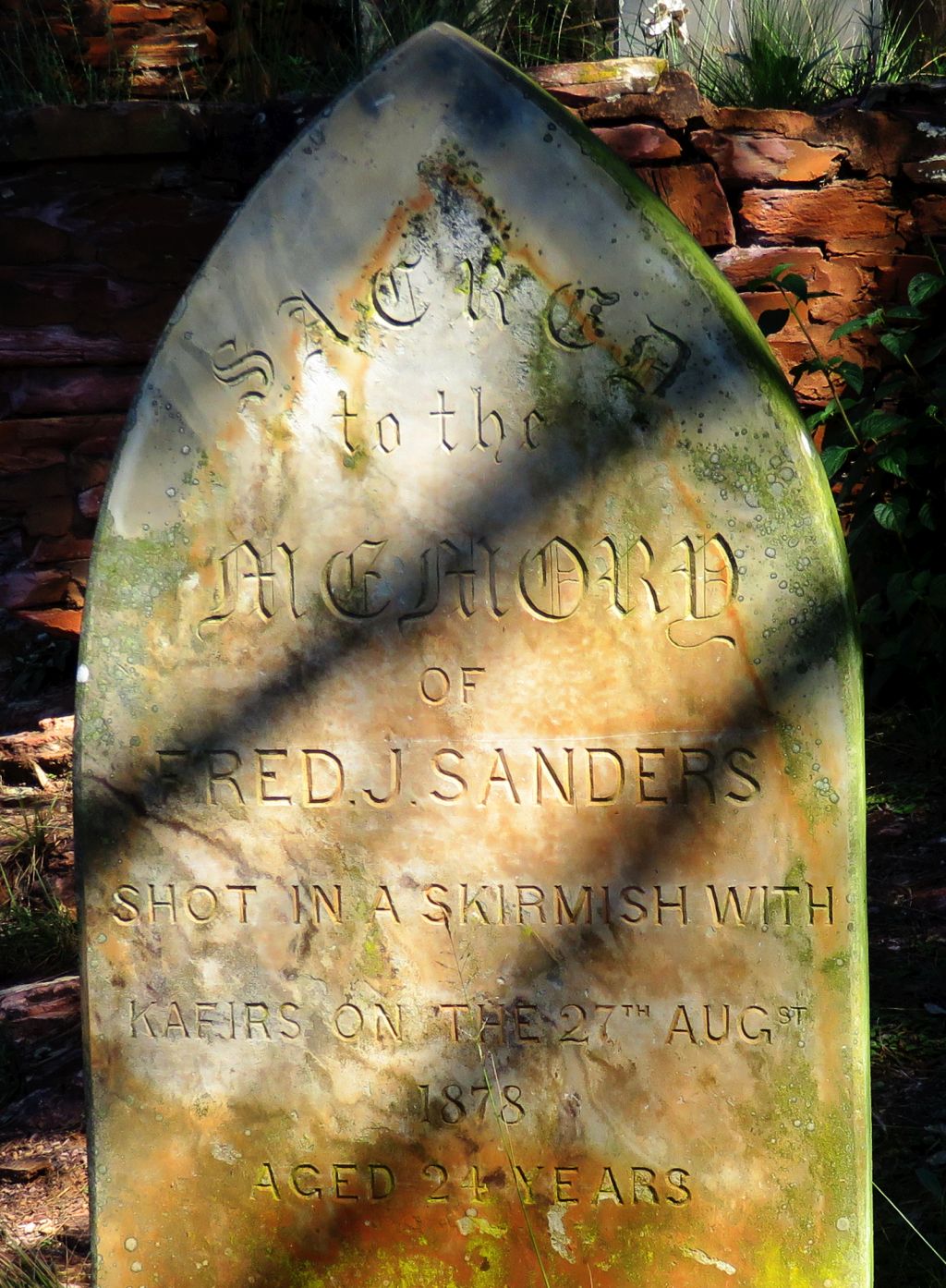 The origin of the Pilgrim's Rest cemetery is closely connected to the legend of the Robber's Grave. The legend tells the story of an unknown man who was caught and convicted of tent robbing on the diggings and who was subsequently banished. A few days after his trial the thief was spotted on the hill, now known as Cemetery Hill, where he was shot and killed -- and buried where he fell His grave lies north-south to brand him forever a thief. Shortly after this incident two other people died and were
buried near the Robber's grave, thus the unplanned origin of the Pilgrim's Rest cemetery on a particular difficult and unpractical terrain.
One of those early graves was that of Fred J.Sanders who died in 1878 as a result of a skirmish with some unruly natives. This could have been during the disturbances of the Sekukuni war.
The origin of the Pilgrim's Rest cemetery is closely connected to the legend of the Robber's Grave. The legend tells the story of an unknown man who was caught and convicted of tent robbing on the diggings and who was subsequently banished. A few days after his trial the thief was spotted on the hill, now known as Cemetery Hill, where he was shot and killed -- and buried where he fell His grave lies north-south to brand him forever a thief. Shortly after this incident two other people died and were
buried near the Robber's grave, thus the unplanned origin of the Pilgrim's Rest cemetery on a particular difficult and unpractical terrain.
One of those early graves was that of Fred J.Sanders who died in 1878 as a result of a skirmish with some unruly natives. This could have been during the disturbances of the Sekukuni war.
the Bridge
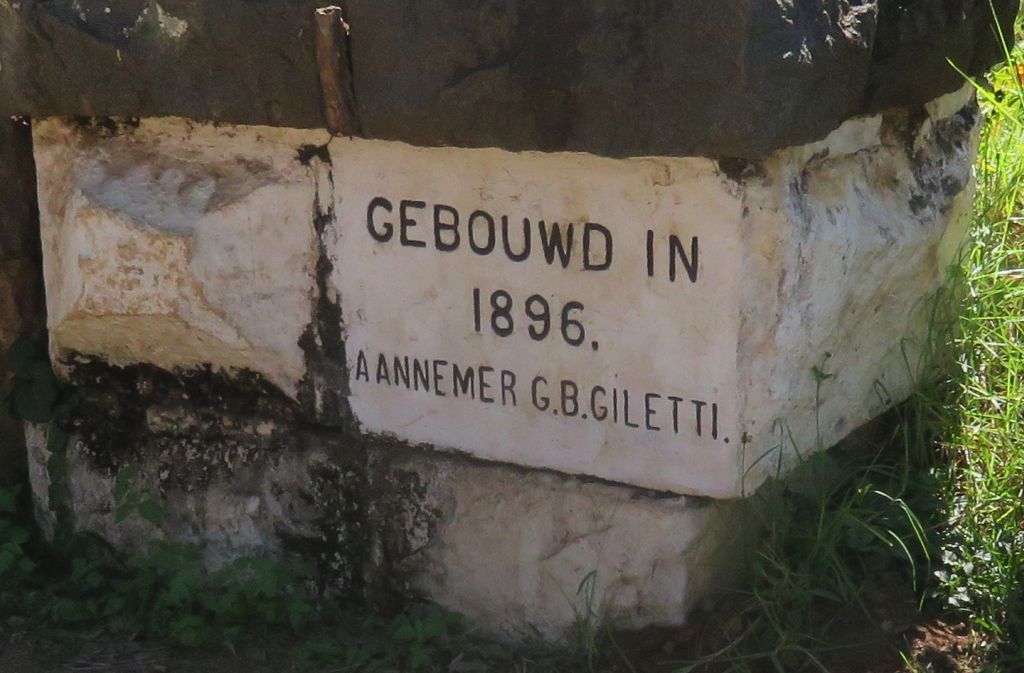 In the early days of gold digging for travellers and supplyers to come to Pilgrims Rest was by crossing the Blyde River to the west of the
In the early days of gold digging for travellers and supplyers to come to Pilgrims Rest was by crossing the Blyde River to the west of the 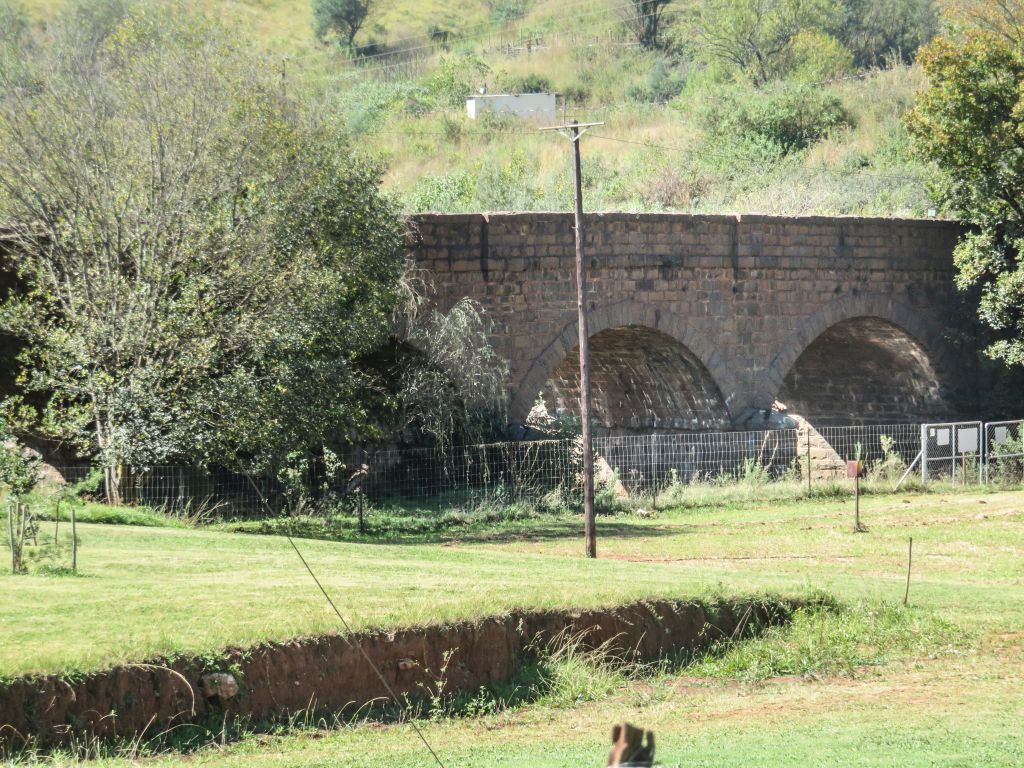 settlement. Crossing was not difficult, unless the river was in flood. There is a story of President Burger coming for a visit early in 1874 being unable to cross because of a strong flowing river. With ropes and manpower the presidents carriage was pulled with the president in it fearing to drown. The visit resulted in a new mining law promulgated to create more order on the fields.
settlement. Crossing was not difficult, unless the river was in flood. There is a story of President Burger coming for a visit early in 1874 being unable to cross because of a strong flowing river. With ropes and manpower the presidents carriage was pulled with the president in it fearing to drown. The visit resulted in a new mining law promulgated to create more order on the fields.
Caves
This being in a dolomitic area there are a number of caves in the area. The most interesting from a historical point of view will be 'Dry Tiger Creek Cave', just a bit upriver from the town. It is not a huge cave, what makes it interesting are the names inscribed in the walls with dates going back to the 1870th. It was obviously a target of outings coming from the town. Inscribing their names is nowadays seen as vandelism, but I forgive them, it would be an interesting exercise to match the names to people that we know used to live in Pilgrims Rest. There is even an inscription dated 1780 something, that is most likely a hoax.
References
Ref 1.: Standard Encyclopedia of Southern Africa, Nasou Limited, 1974
Ref 2.: A.P.Cartwright, Valley of Gold, Timmins Publishers, 1961
Ref 3.: T.V.Bulpin, Lost Trails of the Transvaal, Thomas Nelson and Son, 1965
Ref 4.: A.P.Cartwrite, The Gold Miners, Purnell & Sons, 1962
Ref 5.: H.O.Müller, Dolomite Caves of the Eastern Transvaal', unpublished, 1985